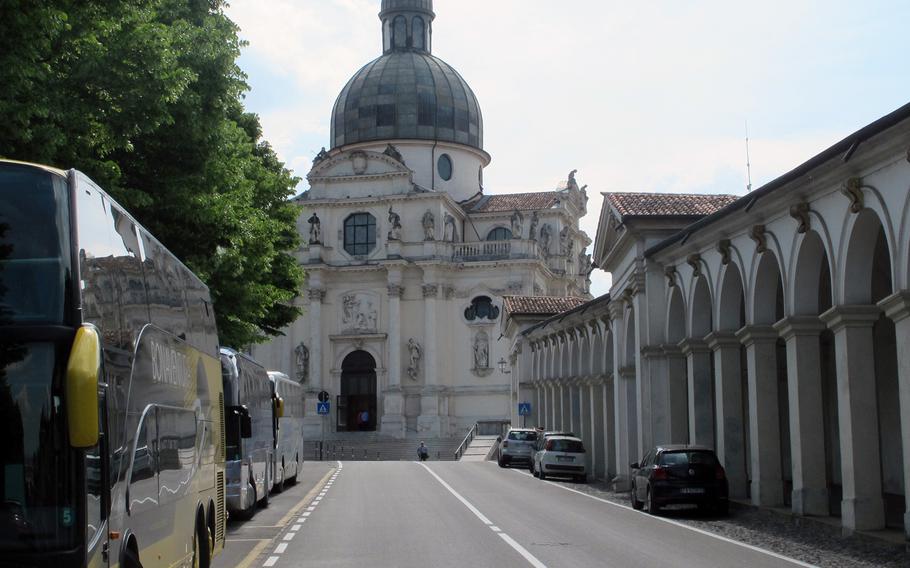
The Sanctuary of the Madonna of Monte Berico is a baroque church built in 1703 by Carlo Borella on the same spot a church had been built in the 15th century asking the Virgin Mary's help in ending the plague. (Nancy Montgomery/Stars and Stripes)
One day back in plague-ridden 1426, an apparition appeared on a hill above Vicenza, Italy, to an old woman who shared the city’s name.
It was the “likeness of a most beautiful queen, with garments more resplendent than the sun, wreathed in a fragrance of a thousand scents,” according to the story, as written by public notaries.
“I am the Virgin Mary, the Mother of Christ,” the vision told the woman. “I beg you to go and say in my name to the people of Vicenza they must build in this place a church in my honor, if they want their health back, otherwise the plague will not cease.”
No one believed her until the second time it happened, two years later, according to the notaries’ report from 1430, kept in the Bertoliana Biblioteca in Vicenza. They built the church in three months.
Half a millennium later, the Santuario della Madonna di Monte Berico stands high above the town, welcoming pilgrims and tourists to worship, to contemplate motherly love, or simply to take in one of the city’s best views. The current edifice was built in the 17th century on the site of original structure.
Sitting impressively atop a road lined with arched arcades, the relatively small church is an eight-minute drive from the city center, up a 100-meter hill. The arcades were built in the 19th century to shelter pilgrims climbing up to the church on foot. The number of arches corresponds to the number of beads on a rosary.
According to 30 Giorgi, an Italian ecclesiastical magazine, some 30,000 people trek to the church on the first Sunday of each month to ask for a grace, give thanks “or simply to pay a visit to the Virgin Mary.”
I’m glad I went on the second Sunday of the month, Mother’s Day, in fact. It wasn’t crowded at all.
I parked the car and gazed out at the expansive view, which included my house and the city’s huge, turquoise-domed Basilica Palladiana, all the way to the Alps and the Euganean Hills.
The church interior is pretty rather than grand and seemed to me quite feminine. At the altar was a statue of Mary as a beautiful queen, sculpted between 1428 and 1430.
The church, a Marion shrine, offers insight into Italian culture, Catholicism and history through its veneration of Mary and its connection to the plague.
According to city documents, between 1404 and 1428, Vicenza “was shaken and tormented almost continuously by most serious pestilence and sickness. And so this province was stripped of its population and of its people.”
The plague, known also as the Black Death, is estimated to have killed 30 to 60 percent of Europe’s population. Caused by a bacterium carried by fleas on shipboard rats, people in the Middle Ages regarded it as a divine punishment — or else they blamed it on bad air, foreigners, Gypsies or Jews.
In the meantime, Mary had become increasingly revered, seen by the 14th-century as a compassionate intercessor with a sterner male God. Numerous churches were dedicated to her during plague outbreaks as the faithful sought her help in turning away God’s wrath or offered thanks after an outbreak burned out.
Santuario della Madonna di Monte Berico
DIRECTIONS
The address of the Santuario della Madonna di Monte Berico is Viale X Giugno, 87, 36100 Vicenza VI
TIMES
Open every day from 6 a.m. to 12:30 p.m. and 2:30 p.m. to 7:30 p.m..
COSTS
Free
FOOD
There are several snack bars nearby. Also a restaurant — packed when I saw it on a Sunday afternoon — is just down a walkway.
INFORMATION
Website: www.monteberico.it (in Italian)